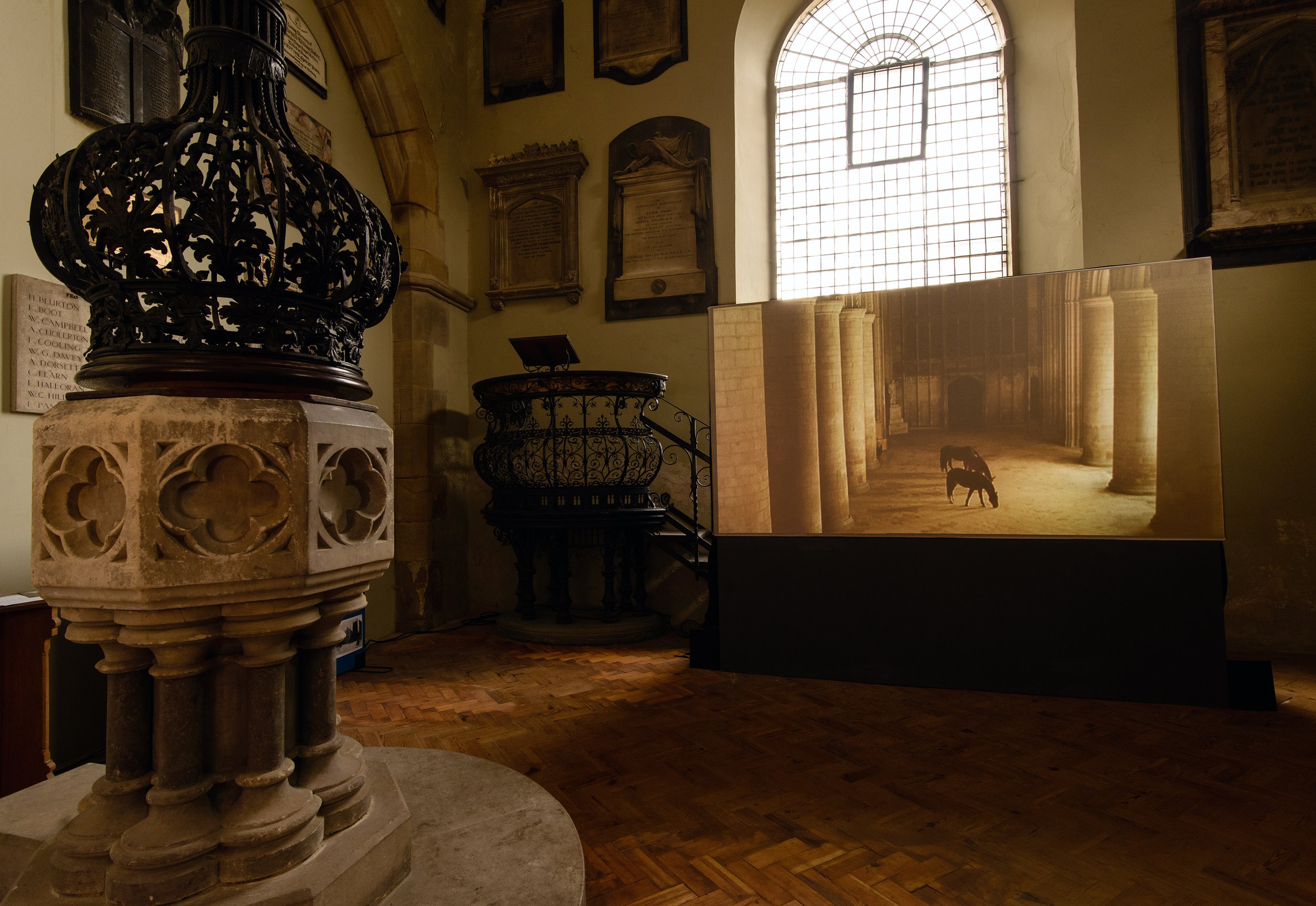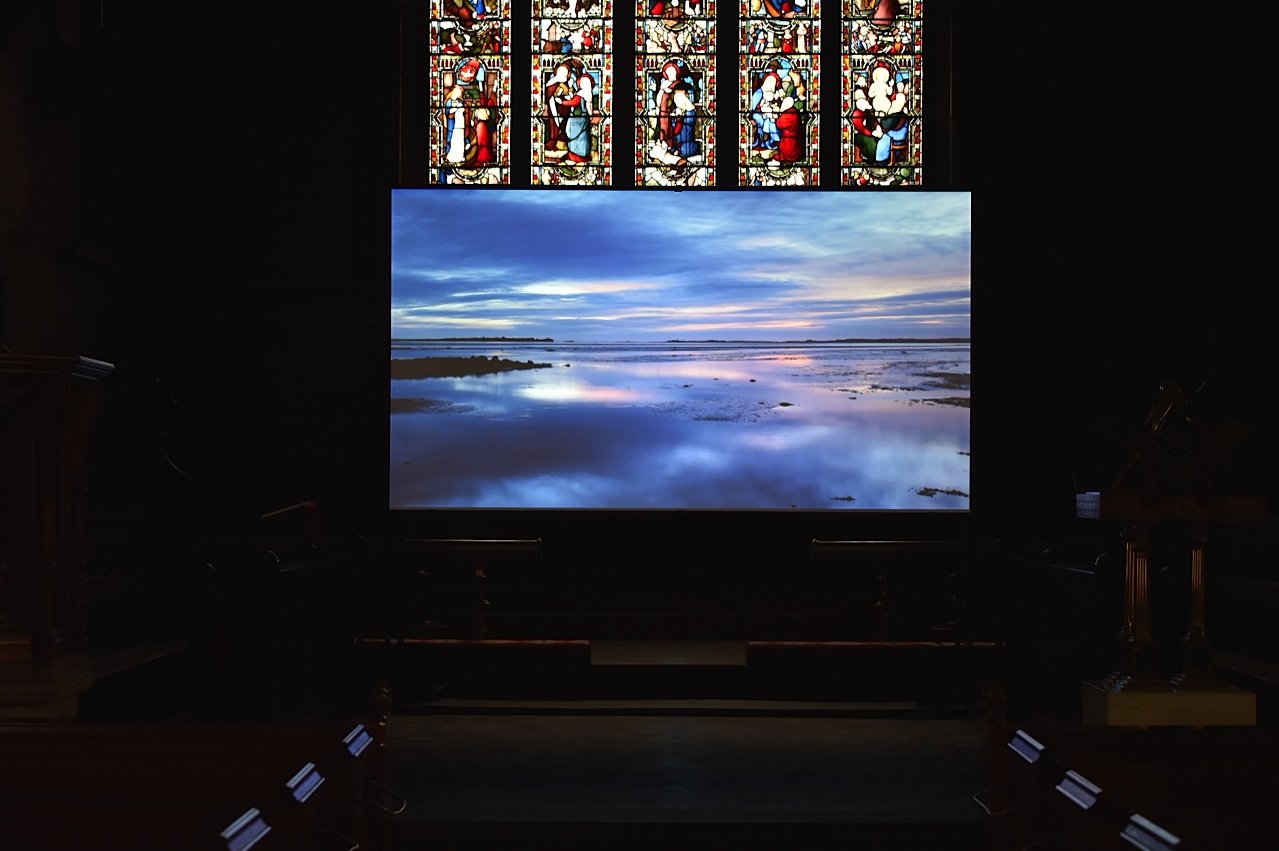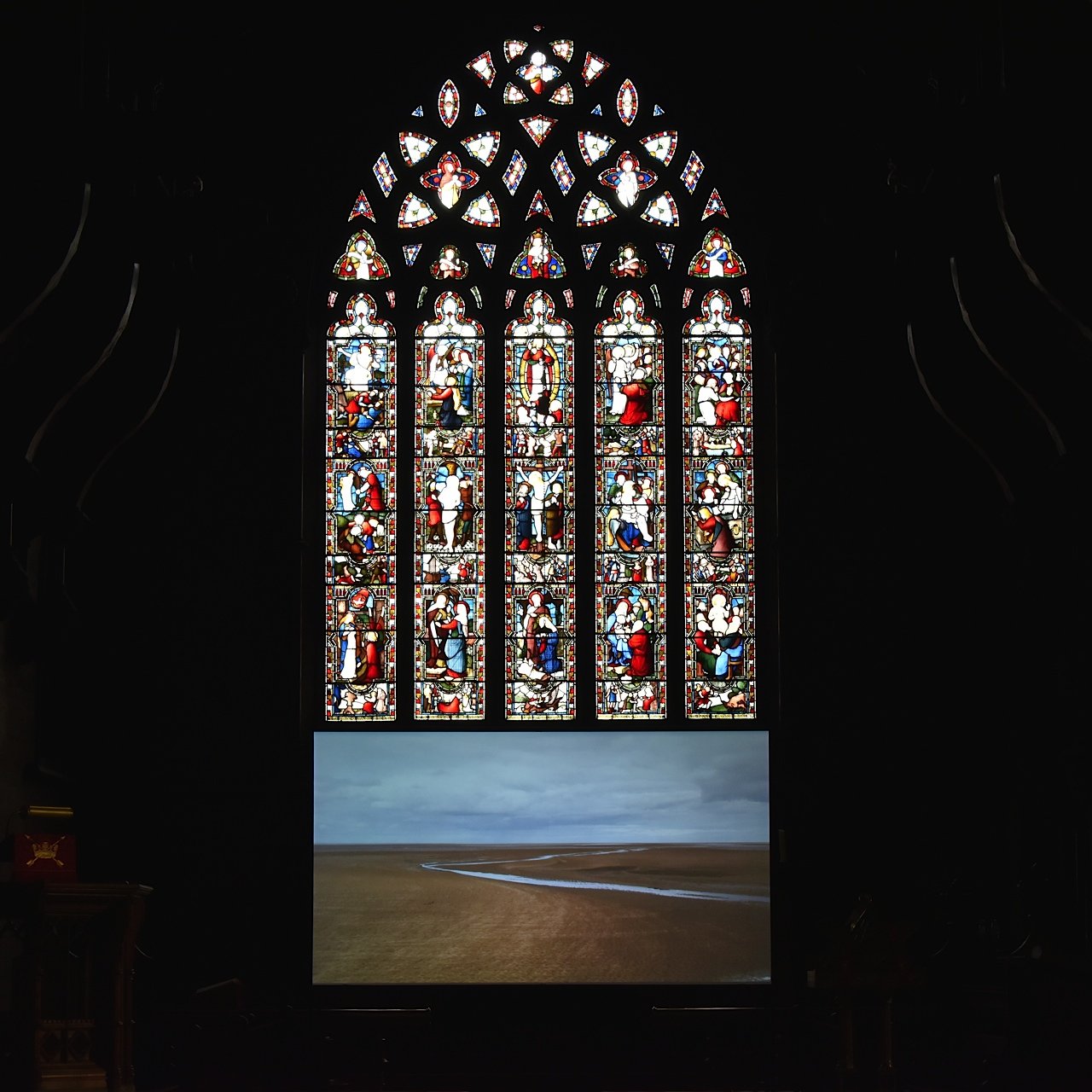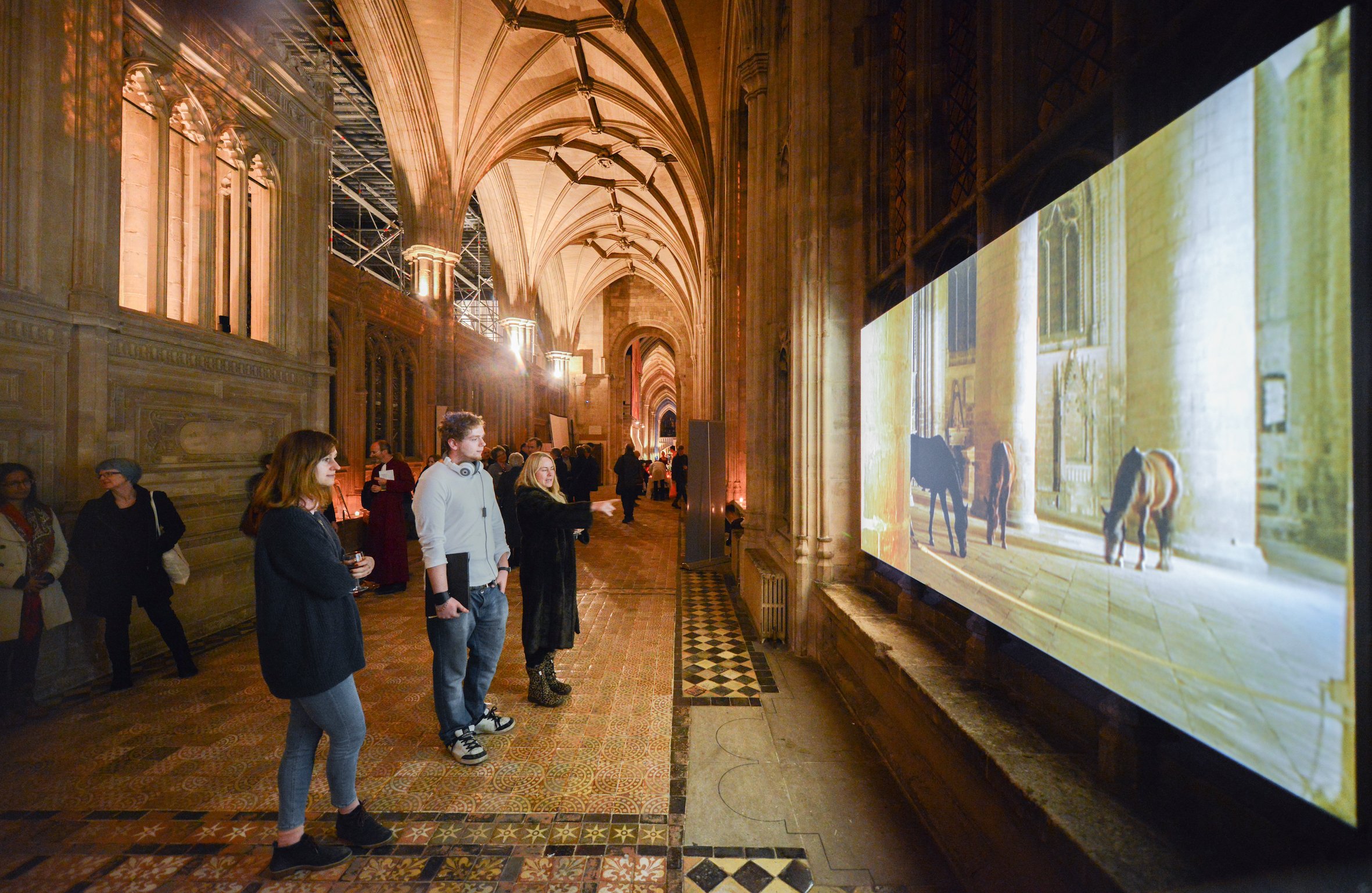Film and video touring exhibition
‘A Light That Shines in the Darkness’: A National Touring Exhibition of Moving Image/Film work
Film and Video Umbrella (FVU) commissions, curates and produces artists' moving-image works and presents them in collaboration with galleries and other cultural partners. This project grew from a series of discussions with curator, Paul Bayley who was initially employed as Projects Director of Art and Christianity but completed the project as a freelance curator. Partnerships were also important in locating suitable church spaces from the Churches Conservation Trust (CCT) and in the interpretation programme notably Art and Christianity who had helped stage the symposium at the end of the tour in Norwich Cathedral.
Between October 2014 and May 2015, FVU toured a programme of artists’ film to churches and cathedrals across the country. The Arts Council supported its aim of reaching high percentages of first-time Contemporary Art attendees by targeting areas with low levels of cultural engagement, the project sought to encourage audiences to see the church spaces in these areas, some of which have fallen out of use, as local resources, and to test the viability of using these spaces as venues where art works could be staged. Curatorially, it was also interesting to see if film or artist moving image could be offered for selection, shown sympathetically and toured. A related aim, in this regard, was to facilitate partner learning to instill confidence and expertise to undertake similar events programmes in the future.
The Tour was ‘bookended’ by showings at Winchester and Norwich Cathedrals. These are of course very different sacred spaces, in centres of cultural activity that have a heavy footfall of heritage tourists and a track record of showing contemporary artwork within the fabric of their buildings.
The buildings
Cathedrals: Winchester, Norwich
Churches: St Leonards Church, Bridgnorth: Church of St John, Lancaster; Church of St Edmund, Rochdale; Church of St Chads, Rochdale; Holy Trinity, Blackburn; St Werburgh’s Church, Derby
The buildings ranged from well-known cathedrals to semi derelict urban churches to sacred spaces now used as heritage buildings owned by the Churches Conservation Trust. Some of the spaces were very well used with regular services and events with dedicated staff facilitating their use whilst others were closed and we had to source volunteers to enable us and our audience to use the building safely. It quickly became clearly we had to develop a bespoke strategy for each leg of the tour and to treat each venue as a one off. Some interiors were too visually compromised for a conventional projector~screen set up whilst others needed a specialist black out to control light levels. A series of site visits with the Film and Video Umbrella technical manager and the curator were needed to troubleshoot and gain the trust of the staff on the ground that were going to be managing the project.
Installation and planning
Partnership working was crucial to the success of the project. FVU were regularly funded by the Arts Council of England to tour artists films so were able to apply for funds knowing with their track record of delivering projects they had a good chance of getting them. Art and Christianity were useful in having key supporters in post at both Norwich and Winchester Cathedrals that would help in getting their projects accepted in chapter and would encourage interpretation of the works chosen. As curator, Paul Bayley was also, at that tim,e working as an advisor to the Churches Conservation Trust (CCT) who were developing an arts strategy. This relationship meant CCT were not only able to supply some match funding but also contribute marketing and volunteers to the project. In short, existing relationships meant that it was possible to be flexible in planning and inventive in how we approached the task of selecting and showing very different artworks in very different venues and liaising with the nine artists who were responsible for creating the works. Interestingly, all the work pre-existed the idea of the tour, which was helpful when it came to asking the venue which work they wanted as all the videos could be accessed and watched online. In the end every work was selected and shown at least once. The subject matter was often tangentially about religion: sacred architecture, leaps of faith, pilgrimage, the ineffable, the sublime and obviously took on a deeper resonance when shown within a sacred space. Also crucially, all the artists had a long and prestigious track record in the contemporary art world giving the project a stamp of quality making Arts Council support easier whilst the prospect of showing within a sacred space was also appealing to the artists when approached for permission to show their work.
Display strategy
The technical challenges of this project were considerable, any initial thoughts that we would be setting up each time with the same kit were soon discounted. Site visits and meetings with the stakeholders suggested that the practical problems needed to be overcome on a case-by-case basis. Different projectors and screens were used and in some instances projection onto the fabric of the building or the use of plasma screens were needed. Sound had to be varied too depending on other activities taking place in the same building. Once again the technical installation skills of Film and Video Umbrella were invaluable and as the lead organisation these costs were absorbed whereas other initiatives attempting a similar project would have to budget in the additional costs of specialist staff and equipment. Likewise the screenings changed from venue to venue running from one night only to 45 days depending on the volunteer resource available in each space.
Interpretation
The branding fed heavily into the exhibition hand-outs which we tailored for each staging, as well as to the brief for the design of our printed leaflet; the fold-out print included information on the overall theme of the programme and on the individual stagings. The copy was written in an accessible way, with short snappy paragraphs on each of the artist films. We decided to design the leaflet in such a way that it could double as a poster, so that it could be pinned to notice boards in local areas. Each staging’s venue, dates, and opening times were also included, alongside a map of the UK pinpointing the locations. We hoped that the leaflet would be displayed with local partner organisations, as well as at each of the exhibition venues to help give additional context to the exhibition. Across the seven stagings, we distributed 5,000 of the 6,000 leaflets printed, which is a significant achievement. CCT used their contacts local to the exhibiting churches to help with the distribution, which would have otherwise been very difficult without staff in the area and without known contacts.
There were also a series of planned one off events that targeted different constituencies. Artist talks were open to all but aimed at a younger contemporary art audience, an ecumenical faith tour: the Rochdale pilgrimage walked through and visited different sacred spaces including a mosque, arriving at the church for a screening and a lunch and was pitched at the casual visitor whilst the symposium at Norwich Cathedral was aimed at a more academic audience and those with a professional interest in the intersection of art and church space.
Audience Numbers
Total audience figure: 31,730
FVU had to give targets for audience reach to the Art Council in the grant application and therefore we also had to keep accurate figure and report back those during evaluation. They estimated that the tour would achieve a total audience figure of 14,744: 14,024 live audiences and 125,720 broadcast, online and in writing. This estimate was significantly exceeded. The totals were 31,730 for the live audience and 537,166 for broadcast, online and in writing. This comes to a total of 568,896, which was nearly 400% greater than our original estimate. The live audience figures are taken from each staging as well as the events programme that accompanied the tour. A large portion of the figures came from the Winchester staging, which had an especially large footfall of 22,000. In terms of the broadcast, online and writing audiences, a large number fell under broadcast, as we secured three major pieces of radio coverage, including: BBC Radio Manchester, BBC Radio Shropshire and BBC Radio Derby. We also included figures for the website hits, social media, and leaflet distribution. If we were to include the reach for all press (i.e. print and online in addition to broadcast) as well as advertising, our total audience reach would come to 5,820,633.
One of the main aims of the project for both Film and Video “Umbrella and the Arts Council was to determine whether there is an appetite for this kind of work within these regions, and spaces. Having massively exceeded our initial estimation for live audiences for the tour, with significant audiences in each of the three regions that we toured to that were in areas recognised as having low arts engagement, we feel that we have established that there is a demand/desire in these places for this sort of work, and that maybe it is the lack of supply that is the issue, not the audience engagement.
Audience demographics
Once again, Film and video Umbrella had to develop a strategy to capture audience data to feedback to the Arts Council. The aim was to achieve a high percentage of first time audiences who fell outside of the usual arts networks. In the lead up to the project launch, an in-depth audience development plan was used based on the Arts Council resource Arts Insight: ‘Audience Spectrum’ (2011).’ Throughout the programme, visitors were encouraged by volunteers to fill out feedback forms. Across the entire programme 31% said they ‘never’ or ‘rarely’ attended contemporary art events/exhibitions, however when you look at the figures for the 5 churches only (as opposed to the Cathedrals both of which were in areas of high arts engagement) this increases to 68.75%, demonstrating that we were able to reach our desired new audiences. One of the main challenges was encouraging audiences from non-religious or non-Christian backgrounds to engage with the programme, as the exhibitions were staged in cathedrals and churches (albeit some of the churches that were no longer active places of worship) and the title of the programme explicitly references Christian Theology (as well as the material intent and conceptual nature of the programme). In terms of marketing, the use of religious language was carefully chosen and the value of the spaces as historic sites was foregrounded as local resources to their communities. At a number of the stagings, the buildings weren’t accessible to audiences on a day-to-day basis and so many audiences were curious about the chance to see inside. Our event, the Rochdale pilgrimage achieved success in reaching specifically non-Christian audiences by inviting the local mosque to participate in the pilgrimage
The written feedback supports the fact that audiences were new to the work, with comments such as ‘Never been to something like this in Blackburn’. Other examples of written comments include, ‘Really enjoyed the pieces - very good opportunity to access this sort of work in Shropshire’; ‘We travelled 40 miles to get here - 80 mile round trip’; ‘Very thought provoking’; ‘Could watch for hours’ and ‘I loved it’.
DAC Involvement
The nature of the buildings meant that no DAC involvement was needed. However it was noticeable that existing links with the local churches definitely helped the project and guaranteed audiences.
Mission
Once again, the nature of the project that was overwhelmingly resourced by public funding (Arts Council and Heritage funds through FVU and CCT) meant that no specific mission (in the Christian sense) rationale was needed. However, individual stakeholders in each of the venue often explicitly invoked mission when discussing or interpreting the work. So it became the focus for a church service at Winchester Cathedral and its selection and use in a contemplative way in a side chapel at Norwich Cathedral were noted. Likewise Three Faiths Forum used the Rochdale showing in an effort to foster greater understanding and reconciliation between different faith communities in a particularly difficult local context.
Conclusion
This was an extremely complex project that ultimately developed into a series of one off exhibitions drawing from the same pool of artist’s films in a wide range of different sacred contexts. It would be wrong to see this complexity as a barrier to others attempting to do something similar. The irony is the very complexity of the project created strong working relationships and engendered extremely cost effective and varied solutions to issues that might have otherwise been insurmountable. These challenges were at different times curatorial, technical, audience and venue related or simply at its most prosaic level concerned with individual and overall budgets. However, the different partners had a clear idea of what they wanted to achieve within the project and were willing to contribute their individual expertise and hard work to ensuring the projects success. The project was delivered to good reviews on time, within budget to a large and enthusiastic audience.





